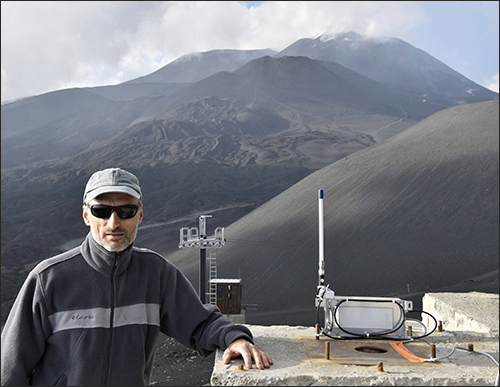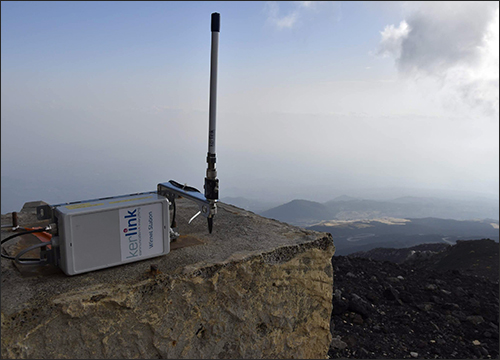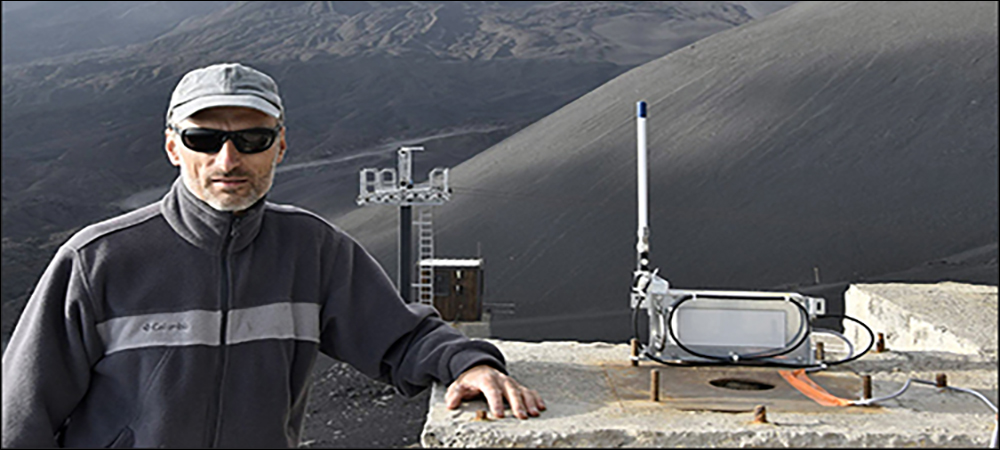French researchers have been tracking the level of radon venting out of Europe’s most active volcano, Mount Etna, in order to better predict when an eruption is imminent. To enable the collection of data even during winter months, the team has employed an automated system to capture data in real time.
The solution, provided by Kerlink, includes LoRaWAN nodes and radon sensors conceived by the Laboratoire de Physique de Clerment, as well as Kerlink’s Wimet gateway, to capture data regarding what is happening on the Sicilian volcano, then forward that information to a dedicated server. The researchers, located 1,200 miles from the volcano in Clermont-Ferrand, can then access and analyze that data in real time.

The project is a cooperative effort between scientists at the Laboratoire de Physique de Clerment and the French National Institute of Nuclear and Particle Physics national laboratory for scientific research. The volcanologists are tracking Mount Etna’s conditions using the technology with funding from the European Regional Development Fund and the Italian Institute for Geophysics and Volcanology (INGV). The wireless sensor system has been in use throughout the winter 2019-2020 season, says Stéphane Dejean, Kerlink’s chief marketing officer.

Kerlink’s Stéphane Dejean
Mount Etna, located on the east coast of Sicily, is one of the world’s most active volcanoes. The 10,000-foot-high peak has five distinct craters, as well as vents on its flanks, and is almost constantly in a state of activity. An eruption in March 2017, for example, injured 10 people. Another in December 2018 shot ash into the air and was followed by a 4.9-magnitude earthquake in neighboring city Catania. What’s more, the mountain is in the process of moving toward the Mediterranean Sea at a rate of about half an inch per year.
Because the volcano is so active, and due to the nearby presence of a large population, volcanologists are closely monitoring the mountain’s emissions. Scientists have been measuring radon in the soil, as well as using meters to detect the radioactive element in its volcanic gasses. Traditionally, without the LoRaWAN-based system, researchers had to gather this data manually. That meant sending individuals near the craters to measure the soil and gasses using portable sensors. That process was not only slow, but it provided sporadic data and could be dangerous. During winter months, it is often impossible to collect data at all, thanks to the snowy conditions.
Therefore, the researchers began working with Kerlink to employ a wireless system that would continually collect data regarding whether or not a researcher was present. The team deployed the system as the winter months approached, with about a dozen nodes and a gateway in place by November 2019. “The benefit here,” Dejean explains, “is that they can permanently get the monitoring or soil and measurement of radon in the air,” despite being 1,200 miles from the laboratory and 10,000 feet higher in elevation. “That’s a major achievement.”
The IoT solution consists of a Kerlink Wirnet station employing loRaWAN technology. The LoRaWAN nodes have been installed near the top of the peak in areas around the craters. Each node has a sensor connected to it that captures radon measurements in plumes of gas, as well as the radon levels being emitted from the craters and vents. The nodes collect that sensor data at preset intervals and forward it via a 3G cellular connection to the server at Clermont-Ferrand, in the French National Institute of Nuclear and Particle Physics.

Scientists are analyzing the resulting data and can thus make projections about the mountain’s conditions. Researchers spent approximately one year planning the deployment and determining how the software would manage the collected data. “The great part in this is the modeling and algorithms,” Dejean states. The software employs artificial intelligence (AI) to analyze the information, thereby defining patterns that could help predict the next eruption.
While the sensors are placed directly in soil or in the craters, the nodes are deployed in nearby areas with a cable connection to the sensors. The solution is focused on collecting radon measurements, since that is the trigger for eruptions. However, the solution could measure other conditions as well, such as air temperature or the density of other gasses.
The challenge for Kerlink, Dejean reports, was to ensure that the hardware could sustain the environment in which it was being deployed. The nodes are exposed to high winds, water, snow and ice, as well as wide changes in temperature. “The challenge was making sure we had a robust product,” he states. Because there is no power source at this location, the team leverage a solar panel to power the gateway station and the cellular connectivity that then transmits data to the server. The system will continue collecting data for future eruption predictions throughout the year, Dejean says, adding, “It’s a major achievement to have this kind of live monitoring.”


